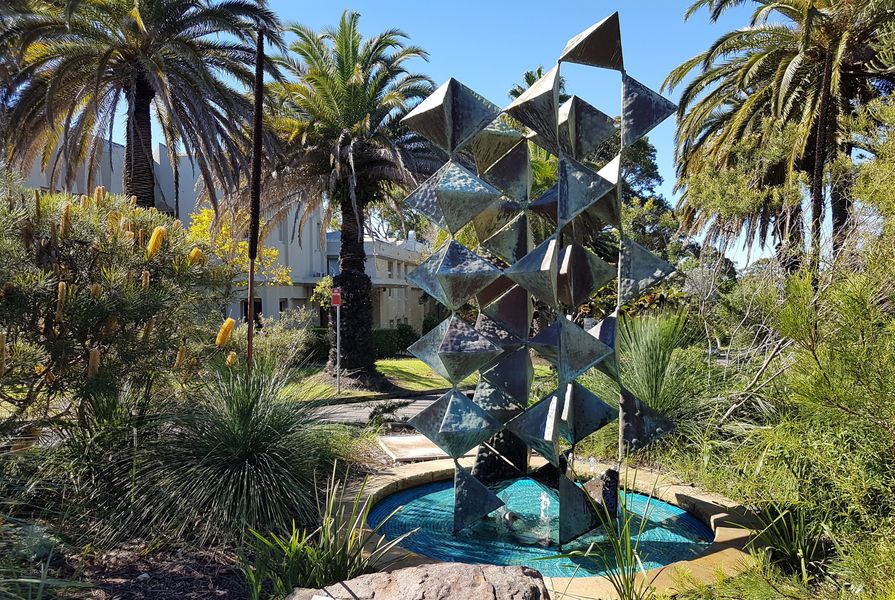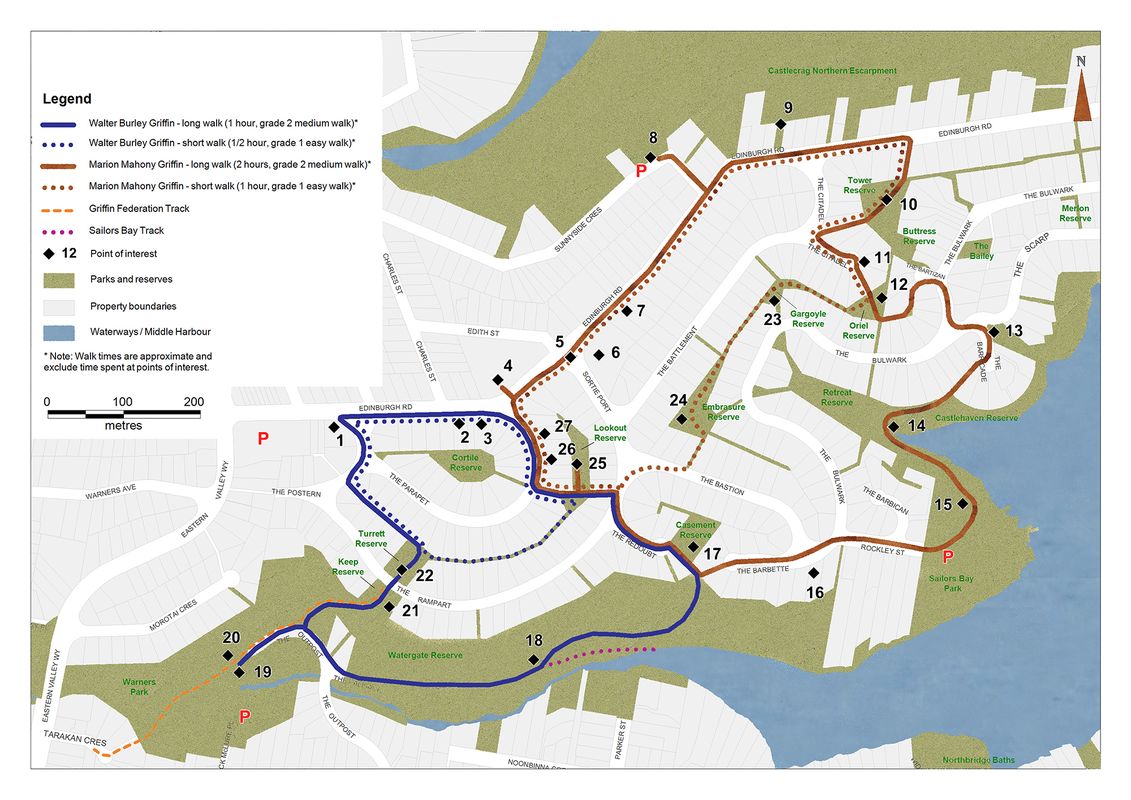The Griffin Reserves system within Castlecrag, on Sydney’s lower north shore, is widely recognized as a community development with rich historical significance for Australian landscape architecture. Begun in 1921, the neighbourhood open space network sprawls across the 50-hectare Griffin Conservation Heritage Area comprising Middle Harbour foreshores, 20 interconnected local parks and reserves, several nature-based playgrounds, vegetated traffic islands and the Griffin’s Haven Amphitheatre, all connected by over five kilometres of off-road walking trails and pathways. Less well known is the backstory of the project’s more contemporary champions, who over the past five decades have collaborated as everyday custodians for this remarkable legacy as landscape professionals, expert volunteers and residents. Many are members of active local community organisations such as the Castlecrag Progress Association, Willoughby Environment Protection Association and the Walter Burley Griffin Society, who uphold the Griffin/Mahony ethos of “building for nature” and support the dedicated work of landscape architects and the open space team within Willoughby City Council (WCC).
The Griffin Reserves, Australia’s first developer-delivered open space system; Greater Sydney Development Association (1920s).
Image: Willoughby City Council
Jan Felton, for instance, is a WCC landscape architect who has worked closely with community representatives for over a dozen years to implement and update The Griffin Reserves Plan of Management. Together with Alfred Bernhard, who leads council’s Bushland team, she has been responsible for site design, community engagement and the day-to-day management of the Griffin Reserves. Community participation in the management and preservation of these landscape architectural elements has been integral to the council’s work in the Griffin Conservation Area. This collaboration has benefited both local residents and visitors. Community participants in the Griffin Reserves Advisory Group (GRAG) have provided council with significant input towards the improvement of the Griffin Reserves and have played a valuable role in the process of making recommendations as well as promoting, over-seeing and reviewing on-ground outcomes.
According to Bernhard, these achievements have included improvements to reserves and walkways to make them more easily accessible and enhancing community amenity and recreation opportunities; vegetation design and management, including the removal of exotic weeds and the planting locally indigenous species that have been linked with the placement of seating allowing users to appreciate spaces and existing views; the development of designated walking tracks; and biennial open days to connect community members, encourage residents to take an active interest in their neighbouring reserves, and to raise awareness of and participation in the council’s Bushcare volunteer program.
As a pilot project for Willoughby Walks, QR coding added interpretive information to the area’s wayfinding signage.
Image: David Martin
Guided by reserve action plans, volunteer Bushcare teams play a vital role in managing weeds and replanting with local provenance species, with these incremental activities accumulating to create a significant improvement in the bushland’s health.
Bushcare leader for The Keep reserve, gardener, long-term volunteer and Castlecrag resident Matthew Keighery said the program had provided an opportunity to expand his knowledge of native plants and work with bushland remnants within a Griffin-designed suburb.
“We aimed to have the garden we purchased [at Castlecrag] merge with the surrounding plant community. The council offered bush care training, plant identification courses and other ways to increase my knowledge of the local ecology.
“Working in the reserves alongside neighbours – knowing we are improving landscapes for flora and fauna while also providing amenity for those that live here and visitors – provides great joy. I view myself as a custodian who is supported by the council’s bushland team, their bush regeneration contractors and other volunteers.”
Keep Reserve team leader Matthew Keighery and volunteers – one of nine Castlecrag bushcare groups.
Image: David Martin
Community fairs and reserve open days are used to engage the community and attract volunteers.
Image: David Martin
Local resident, experienced bush regenerator and horticulturist Richard Blacklock provides services to Willoughby City Council and local organisations such as the Steiner School, which has a junior campus in Castlecrag and a senior school in nearby Middle Cove. Blacklock’s mother Beverley Blacklock was an influential figure in the local community during the 1970s and 1980s, setting up a native garden and plant nursery in Castlecrag at a time when bush regeneration and an appreciation of local plant ecology began to influence the architects and landscape architects, that later became known as the Sydney School.
“Beverley became involved in bush regeneration, helped to start the Castlecrag Conservation Society and was its president for several years,” said Blacklock. “She was a great ‘hassler’ of councils and the Water Board when they didn’t do the right thing by the environment. She was also responsible for the Water Board’s first restoration effort using locally indigenous plants.”
Blacklock sees a need to not only nurture local bushland, but also a duty to share and nurture knowledge development with local school students.
“The council has promoted the Griffin Reserve system of reserves, pathways and road islands and is creating incremental improvements. This is helping people to understand that Castlecrag is a place where Banksia, Acacia, Hardenbergia, flannel flowers and even Juncus [rushes] have become the norm. Most of the younger generations understand the palette of plants and colours that we are working with – it’s what they expect to see and plant. Children are viewing plant choice and gardens through a completely different lens to 20 years ago.”
Bush regenerators Richard Blacklock and Lindsay Sherrot teach bush regeneration and propagation to students at the Glenaeon Rudolf Steiner School.
Image: courtesy Richard Blacklock
In many ways, Castlecrag provides a model for stronger community engagement in the everyday challenges of nurturing local green space, sharing knowledge with new residents and actively fostering the next generation of custodians. In her sesquicentenary year, Marion Mahony Griffin may well be proud of her and Walter’s legacy, looking down over “the Crag” a century on from its inception.
Author’s note: Adrienne Kabos, Meredith Walker and James Weirick’s book, Building for Nature: Walter Burley Griffin and Castlecrag (Sydney: Walter Burley Griffin Society, 1994); Shirley Stackhouse’s article ‘Love and hard work help to save Sydney’s bushland (‘In your Garden’ column, Sydney Morning Herald, 1990) and various issues of the The Crag newsletter (Castlecrag Progress Association, 2019–2021) were used as references during research for this article.
























